
myCBSEguide App
Download the app to get CBSE Sample Papers 2024-25, NCERT Solutions (Revised), Most Important Questions, Previous Year Question Bank, Mock Tests, and Detailed Notes.
Install NowCBSE class 9 Science Chapter 12 Sound notes in PDF are available for free download in myCBSEguide mobile app. The best app for CBSE students now provides Sound class 9 Notes latest chapter wise notes for quick preparation of CBSE exams and school based annual examinations. Class 9 Science notes on Chapter 12 Sound are also available for download in CBSE Guide website.
CBSE Guide Sound class 9 Notes
CBSE guide notes are the comprehensive notes which covers the latest syllabus of CBSE and NCERT. It includes all the topics given in NCERT class 9 Science text book. Users can download CBSE guide quick revision notes from myCBSEguide mobile app and my CBSE guide website.
9 Science notes Chapter 12 Sound
Download CBSE class 9th revision notes for Chapter 12 Sound in PDF format for free. Download revision notes for Sound class 9 Notes and score high in exams. These are the Sound class 9 Notes prepared by team of expert teachers. The revision notes help you revise the whole chapter in minutes. Revising notes in exam days is on of the best tips recommended by teachers during exam days.
Download Revision Notes as PDF
CBSE Class 9 Science
Revision Notes
CHAPTER – 12
Sound
1. Production of Sound Sound is produced due to the vibration of objects. Vibration is the rapid to and fro motion of an object.
Vibrating objects are the source of all sounds Irregular, chaotic vibrations produce noise Regular, controlled vibration can produce music. All sound is a combination of pure frequencies. A stretched rubber band when plucked vibrates and produces sound.
2. Propagation of Sound When an object vibrates, the particles around the medium vibrate. The particle in contact with the vibrating object is first displaced from its equilibrium position.
The disturbance produced by the vibrating body travels through the medium but the particles do not move forward themselves.
A wave is a disturbance which moves through a medium by the vibration of the particles of the medium. So sound is considered as a wave. Sound waves Require medium for transmission.
Sound waves are called mechanical waves When a vibrating object moves forward, it pushes and compresses the air in front of it forming a region of high pressure called compression (C). When the vibrating object moves backward, it forms a region of low pressure called rarefaction(R).
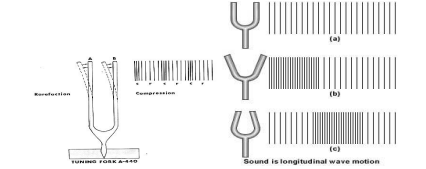
A vibrating object producing a series of compressions (C) and rarefaction (R)
In these waves the particles move back and forth parallel to the direction of propagation of the disturbance. Such waves are called longitudinal waves.
There is another kind of waves called transverse waves. In these waves the particles oscillate up and down perpendicular to the propagation of the direction of disturbance.
Sound propagates in a medium as a series of compressions (C) and rare factions (R).
Compressions are the regions of high pressure and density where the particles are crowded andare represented by the upper portion of the curve called crest.
Rarefactions are the regions of low pressure and density where the particles are spread out and are represented by the lower portion of the curve called trough
Characteristics of a sound wave
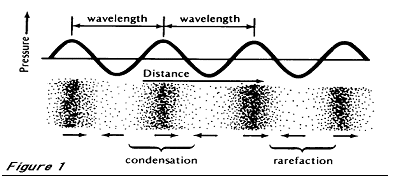
Frequency of sound wave
The number of oscillations per unit time is called the frequency of the sound wave. It is represented by the symbol v (Greek letter nu). Its SI unit is hertz (Hz)
Time period of sound wave:
The time taken by wave to complete one oscillation is called time-period.
Frequency and time are represented as follows :-
V for one oscillation
Amplitude of sound wave
The amplitude of sound wave is the height of the crest or tough.
It is represented by the letter A.
The SI unit is the same as that of density or pressure.
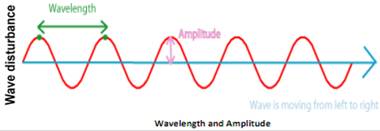
The wavelength is the distance between the “crests” of two waves that are next to each other.
The amplitude is how high the crests are.
Pitch and loudness of sound
The pitch of sound (shrillness or flatness) depends on the frequency of vibration.
If the frequency is high, the sound has high pitch and if the frequency is low, the sound has low pitch
Speed of sound
The speed of sound is more in solids, less in liquids and least in gases.
The speed of sound also depends on the temperature of the medium. If the temperature of the medium is more, the speed of sound is more
3. Reflection of Sound
Sound gets reflected at the surface of a solid or liquid and follows the laws of reflection.
- The angle of incidence is equal to the angle of reflection.
- The incident ray, the reflected ray and normal at the point of incidence all lie in the same plane.
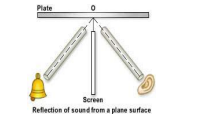
4. Echo
If we shout or clap near a reflecting surface like tall building or a mountain, we hear the same sound again. This sound which we hear is called echo. It is caused due to the reflection of sound. To hear an echo clearly, the time interval between the original sound and the echo must be at least 0.1 s.
Since the speed of sound in air is 344 m/s, the distance travelled by sound in 0.I s = 344
. So to hear an echo clearly, the minimum distance of the reflecting surface should be half this distance that is 17.2 m.
Reverberation
Echoes may be heard more than once due to repeated or multiple reflections of sound from several reflecting surfaces. This causes persistence of sound called reverberation.
In big halls or auditoriums to reduce reverberation, the roofs and walls are covered by sound absorbing materials like compressed fibre boards, rough plaster or draperies.
5. Uses of Multiple Reflection Of Sound
i) Megaphones, horns, musical instruments like trumpets, etc. are deigned to send sound by multiple reflection in a particular direction without spreading in all directions.
ii) Doctors listen to sounds from the human body through a stethoscope. The sound of heartbeat reaches the doctor’s ears by multiple reflection.
iii) Generally the ceilings of cinema halls and auditoriums are curved so that sound after multiple reflection reaches all parts of the hall. Sometimes a curved sound board is placed behind the stage so that sound after multiple reflection spreads evenly across the hall.
6. Range of Hearing
Human beings can hear sound frequencies between 20 Hz and 2000 Hz., called as audible range of sound.
Sound whose frequency is less than 20 Hz is called infrasonic sound
Sound whose frequency is more than 2000 Hz is called ultrasonic sound
7. Uses of ultrasonic sound
Ultrasonic sound is used to clean objects like electronic Components, used to detect cracks in metal blocks, used in ultra sound scanners for getting images of internal organs of the human body used to break small stones formed in the kidneys into fine grains.
8. Sonar
It is a device which uses ultrasonic waves to measure distance, direction and speed of underwater objects. The distance of the object can be calculated by knowing the speed of sound in water and the time taken between the transmission and reception of ultrasound
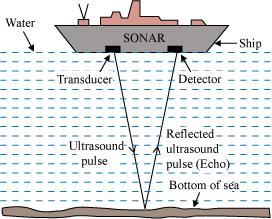
9.Structure of the human ear
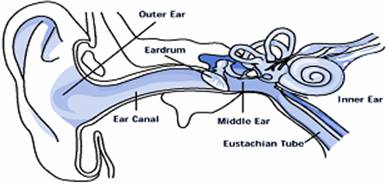
The sound waves passes through the ear canal to a thin membrane called eardrum. The eardrum vibrates. The vibrations are amplified by the three bones of the middle ear calledhammer, anvil and stirrup. Middle ear then transmits the sound waves to the inner ear. The brain then interprets the signals as sound.
Sound class 9 Notes
- CBSE Revision notes (PDF Download) Free
- CBSE Revision notes for Class 9 Science PDF
- CBSE Revision notes Class 9 Science – CBSE
- CBSE Revisions notes and Key Points Class 9 Science
- Summary of the NCERT books all chapters in Science class 9
- Short notes for CBSE class 9th Science
- Key notes and chapter summary of Science class 9
- Quick revision notes for CBSE exams
CBSE Class-9 Revision Notes and Key Points
Sound class 9 Notes. CBSE quick revision note for Class-9 Science, Chemistry, Maths, Biology and other subject are very helpful to revise the whole syllabus during exam days. The revision notes covers all important formulas and concepts given in the chapter. Even if you wish to have an overview of a chapter, quick revision notes are here to do if for you. These notes will certainly save your time during stressful exam days.
- Revision Notes for class-09 Mathematics
- Revision Notes for class-09 Science
- Revision Notes for class-09 Social Science
- Revision Notes for class-09 English Communicative
To download Sound class 9 Notes, sample paper for class 9 Mathematics, Social Science, Science, English Communicative; do check myCBSEguide app or website. myCBSEguide provides sample papers with solution, test papers for chapter-wise practice, NCERT solutions, NCERT Exemplar solutions, quick revision notes for ready reference, CBSE guess papers and CBSE important question papers. Sample Paper all are made available through the best app for CBSE students and myCBSEguide website.
- Matter in Our Surrounding class 9 Notes Science
- Is Matter around Us Pure class 9 Notes Science
- Atoms and Molecules class 9 Notes Science
- Structure of the Atoms class 9 Notes Science
- The Fundamental Unit of Life class 9 Notes Science
- Tissues class 9 Notes Science
- Diversity in Living Organisms class 9 Notes Science
- Motion class 9 Notes Science
- Forces and Laws of Motion class 9 Notes Science
- Gravitation class 9 Notes Science
- Work and Energy class 9 Notes Science
- Sound class 9 Notes Science
- Why Do We Fall ill class 9 Notes Science
- Natural Resources class 9 Notes Science
- Improvement in Food Resources class 9 Notes Science

Test Generator
Create question paper PDF and online tests with your own name & logo in minutes.
Create Now
myCBSEguide
Question Bank, Mock Tests, Exam Papers, NCERT Solutions, Sample Papers, Notes
Install Now